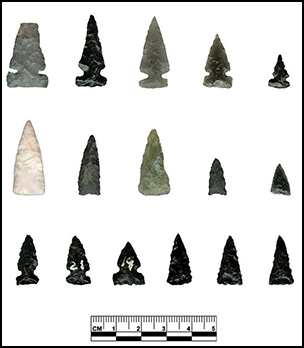Crossref Citations
This article has been cited by the following publications. This list is generated based on data provided by
Crossref.
Loendorf, Chris
Oliver, Theodore J.
Tiedens, Shari
Scott Plumlee, R.
Kyle Woodson, M.
and
Simon, Lynn
2015.
Flaked-stone projectile point serration: A controlled experimental study of blade margin design.
Journal of Archaeological Science: Reports,
Vol. 3,
Issue. ,
p.
437.
Whittaker, John C.
2016.
Arrowheads, folklore, and documentary sources.
Plains Anthropologist,
Vol. 61,
Issue. 238,
p.
177.
Loendorf, Chris
and
Lewis, Barnaby V.
2017.
ANCESTRAL O'ODHAM: AKIMEL O'ODHAM CULTURAL TRADITIONS AND THE ARCHAEOLOGICAL RECORD.
American Antiquity,
Vol. 82,
Issue. 1,
p.
123.
Kaňáková, Ludmila
Bátora, Jozef
and
Nosek, Vojtěch
2019.
Use-wear and ballistic analyses of arrowheads from the burial ground of the Nitra culture in Ludanice - Mýtna Nová Ves.
Journal of Archaeological Science: Reports,
Vol. 23,
Issue. ,
p.
25.
Loendorf, Chris
Fertelmes, Craig
DeJong, David H.
Kyle Woodson, M.
and
Lewis, Barnaby V.
2019.
Blackwater Village at the Turn of the Twentieth Century: Akimel O’Odham Perseverance and Resiliency.
KIVA,
Vol. 85,
Issue. 1,
p.
25.
Clark, Jeffery J.
Birch, Jennifer A.
Hegmon, Michelle
Mills, Barbara J.
Glowacki, Donna M.
Ortman, Scott G.
Dean, Jeffrey S.
Gauthier, Rory
Lyons, Patrick D.
Peeples, Matthew A.
Borck, Lewis
and
Ware, John A.
2019.
Resolving the migrant paradox: Two pathways to coalescence in the late precontact U.S. Southwest.
Journal of Anthropological Archaeology,
Vol. 53,
Issue. ,
p.
262.
Loendorf, Chris
Rogers, Thatcher
Oliver, Theodore J.
Huttick, Brian R.
Denoyer, Allen
and
Woodson, M. Kyle
2019.
Projectile Point Reworking: An Experimental Study of Arrowpoint Use Life.
American Antiquity,
Vol. 84,
Issue. 2,
p.
353.
Kaňáková, Ludmila
2020.
Lithic Arrowheads of the Nitra Culture – The Use of Actual and Experimental Use-Wear Analyses to Identify the Differential Effects of Quiver Transportation.
Lithic Technology,
Vol. 45,
Issue. 4,
p.
283.
Kaňáková, Ludmila
Bátora, Jozef
and
Nosek, Vojtěch
2020.
Use-wear and ballistic analysis of arrowheads from the burial ground of Nitra culture in Holešov–Zdražilovska, Moravia.
Journal of Archaeological Science: Reports,
Vol. 29,
Issue. ,
p.
102126.
Vierra, Bradley J.
Chapin, Nicholas
Stevenson, Christopher M.
and
Shackley, M. Steven
2020.
Another Look at Expedient Technologies, Sedentism, and the Bow and Arrow.
KIVA,
Vol. 86,
Issue. 4,
p.
482.
Medina, Matías E.
and
Balena, Imanol
2021.
Ancient Hunting Strategies in Southern South America.
p.
33.
Kaňáková, Ludmila
Mazáčková, Jana
Nosek, Vojtěch
and
Huta, Petr
2022.
External and Terminal Ballistics of Early Bronze Age Lithic Arrowheads: Experimental Verification.
Lithic Technology,
Vol. 47,
Issue. 3,
p.
266.
Loendorf, Dr. Chris
Eckert, Suzanne
Woodson, M. Kyle
and
Medchill, Brian
2022.
Eastern Puebloans on the Middle Gila River:The Middle Rio Grande Diaspora and Periodic Changes in Cultural Traditions.
SSRN Electronic Journal ,
Loendorf, Chris
Eckert, Suzanne L.
Medchill, Brian
and
Kyle Woodson, M.
2023.
Rio Grande cultural remains on the middle Gila River, Arizona: The Pueblo Revolt and the Eastern Puebloan diaspora.
Journal of Archaeological Science: Reports,
Vol. 47,
Issue. ,
p.
103775.
Marsh, Erik J.
Llano, Carina
Cortegoso, Valeria
Castro, Silvina
and
Yebra, Lucia
2023.
The bow and arrow in South America.
Journal of Anthropological Archaeology,
Vol. 69,
Issue. ,
p.
101471.
Bischoff, Robert J.
2023.
Investigating Material Culture Through Multilayer Network Analysis in Tonto Basin.
KIVA,
Vol. 89,
Issue. 3,
p.
247.





